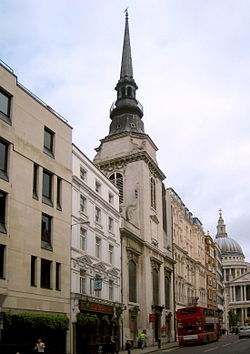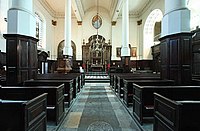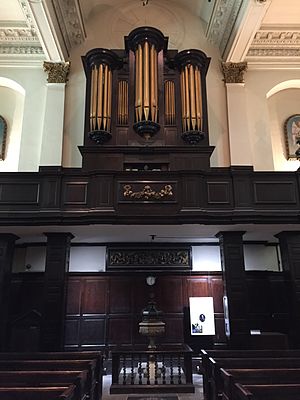St Martin, Ludgate
| St Martin, Ludgate | |
|
London, Middlesex | |
|---|---|
 St Martin, Ludgate | |
| Church of England | |
| Diocese of London | |
| Location | |
| Location: | 51°30’51"N, 0°6’7"W |
| Address: | Ludgate Hill |
| History | |
| Baroque | |
| Information | |
St Martin, Ludgate is a Church of England church on Ludgate Hill in the ward of Farringdon, in the City of London. St Martin, Ludgate, also called St Martin within Ludgate, was rebuilt in 1677–84 by Sir Christopher Wren.[1]
The church is designated a Grade I listed building.[2]
History
Some legends connect the church with legendary King Cadwallo (now usually referred to as Cadwallon ap Cadfan, father of Cadwaladr. A sign on the front of the church reads "Cadwallo King of the Britons is said to have been buried here in 677". Modern historians would place his death about 682. Cadwallo's image was allegedly placed on Ludgate, to frighten away the Saxons. However, Middlesex and the London area were controlled by the Anglo-Saxon polities at that time and there is no evidence of British or any other occupation of the intramural area of the abandoned 'Londinium' since the late fourth century. Previously the sign stated that it was the West Saxon king Caedwalla but this was contradicted by Bede's writings that he was buried in Rome.[3] The earliest written reference is from 1174.
A Blackfriars monastery was built nearby in 1278. The church was rebuilt in 1437 and the tower was struck by lightning in 1561. The parish books start from 1410. Before the Reformation, the church was under the control of Westminster Abbey, and afterwards under St Paul's Cathedral.

St Martin of Tours was considered a patron saint of travellers, and churches which are dedicated to him often stand just within city gates. A blue plaque next to church records the earlier presence of Ludgate, demolished 1760. From the lower part of Fleet Street the steeple stands between the viewer and the dome of St Paul's Cathedral. Wren probably planned to make a contrast between the spiky steeple of St Martin's and the circular dome of St Paul's.[4] It is a curious combination of a lead-clad dome, topped by a lantern and on top of that a sharp obelisk steeple, somewhat like an exclamation mark.[5]

In "The Roaring Girl, or Moll Cutpurse" by Dekker and Middleton, Sebastian says "The clock at Ludgate, sir, it ne'er goes true". This might refer to St Martin's church. "I owe you three farthings, say the bells of St Martin", might refer to this church, but is more likely to refer to St Martin Orgar in Cannon Street (previously Eastcheap). In 1614 Samuel Purchas, a travel writer, became the rector.
On the 17th century font there is a Greek palindrome – 'ΝΙΨΟΝ ΑΝΟΜΗΜΑΤΑ ΜΗ ΜΟΝΑΝ ΟΨΙΝ' (Cleanse my sin and not my face only). There is a 17th-century carved oak double churchwarden's chair[6] – the only one of its kind known to exist.
The mediæval church was repaired in 1623, only to be destroyed in the Great Fire of London in 1666.[7] Rebuilding was not immediate, but was largely completed by 1680, finished in 1703. In 1669 a Roman tombstone, now in the Ashmolean Museum, was found. The current design is topped by a lead-covered octagonal cupola supporting a balcony and tapered spire rising to a height of 158 feet. The centre of the church is in the form of a Greek cross, with four large columns. The chandelier dates from about 1777 and comes from the West Indies. As a curiosity, this is from the burial register: "“1615, February 28, St. Martin’s, Ludgate, was buried an anatomy from the College of Physicians.” (It was first noticed by Andrew Lang, in an article in "Books and Bookmen"). The Royal College of Physicians were based in Amen Corner, a few yards away from 1614 to 1666.[8] In 1678 Robert Hooke designed a new hall in Warwick Lane, also nearby.
The view from the steeple towards the river is spectacular. It was painted by T.M. Baynes.
In 1893 to 1894, the church underwent a major rebuilding and alteration, with the floor level raised, and many bodies disinterred from the churchyard and reburied at Brookwood Cemetery.[9]
In 1941, during the London Blitz, a German incendiary bomb damaged the roof, but St Martin's received relatively little damage during the Second World War. In 1954 St Martin's became a Guild Church.
Organ

The organ is a Bernard Schmidt design dating from 1684.[10] There are carvings by Grinling Gibbons inside.[11] The contemporary carvings in the church are also attributed to three joiners, Athew, Draper and Poulden, and to the carvers Cooper and William Newman.[12] There are organ recitals every other Monday; chamber music every Wednesday and Friday.
A specification of the organ can be found on the National Pipe Organ Register.
Outside links
| ("Wikimedia Commons" has material about St Martin, Ludgate) |
- St Martin's-within-Ludgate website
- photograph
- Cadwallo – Cadwallader
- Looking At buildings
- Greek Palindrome
- The 1615 Anatomy
- Roman inscription
- Live Music
- View from the steeple
- 360° panorama inside St Martin's-within-Ludgate
References
- ↑ "The London Encyclopaedia" Hibbert,C;Weinreb,D;Keay,J: London, Pan Macmillan, 1983 (rev 1993,2008) ISBN 978-1-4050-4924-5
- ↑ National Heritage List 1359194: St Martin Ludgate
- ↑ Tony Sharp: The Farringdon Wards of the City of London a ... History p59
- ↑ "The Old Churches of London" Cobb,G: London, Batsford, 1942
- ↑ "The City of London Churches" Betjeman,J Andover, Pikin, 1967 ISBN 0-85372-112-2
- ↑ "London:the City Churches” Pevsner,N/Bradley,S New Haven, Yale, 1998 ISBN 0-300-09655-0
- ↑ "The City Churches" Tabor, M. p83:London; The Swarthmore Press Ltd; 1917
- ↑ Mentioned in Pepys Diary "Samuel Pepys – The Shorter Pepys" Latham,R(Ed) p484: Harmondsworth,1985 ISBN 0-14-009418-0
- ↑ "The Brookwood Necroplois Railway" Clarke,J.M: Oasdale, Usk, 2006 ISBN 978-0-85361-655-9
- ↑ Pearce,C.W. “Notes on Old City Churches: their organs, organists and musical associations” London, Winthrop Rogers Ltd 1909
- ↑ "The Visitors Guide to the City of London Churches" Tucker,T: London, Friends of the City Churches, 2006 ISBN 0-9553945-0-3
- ↑ Bradley and Pevsner, London: The City Churches, p. 103.
